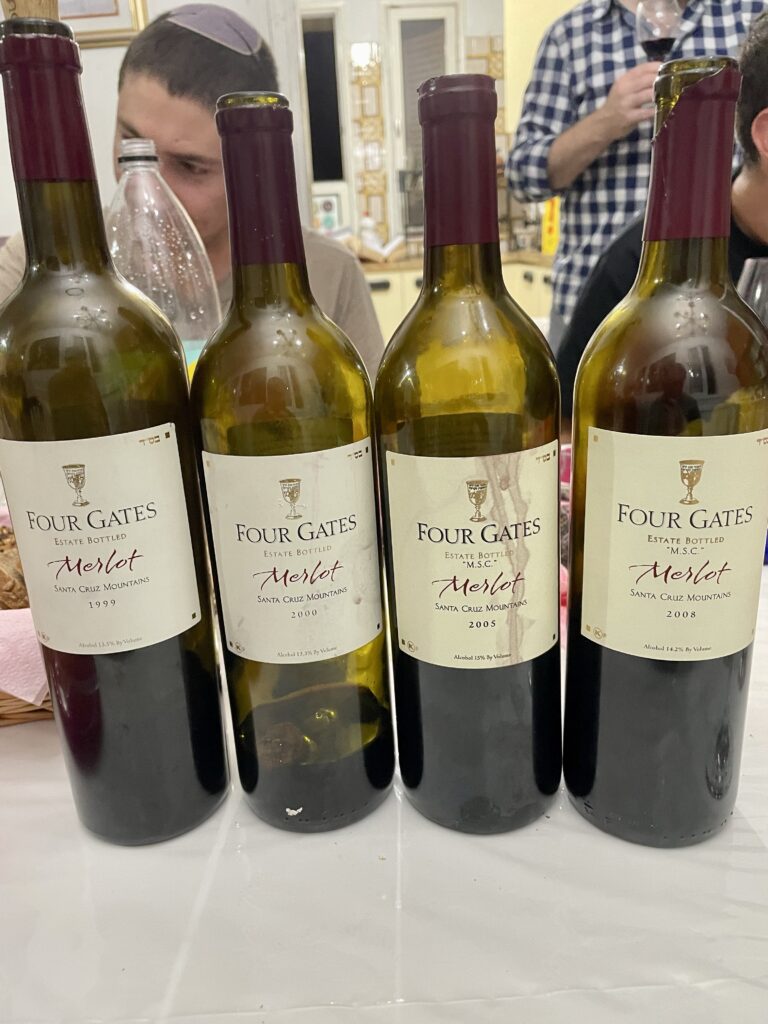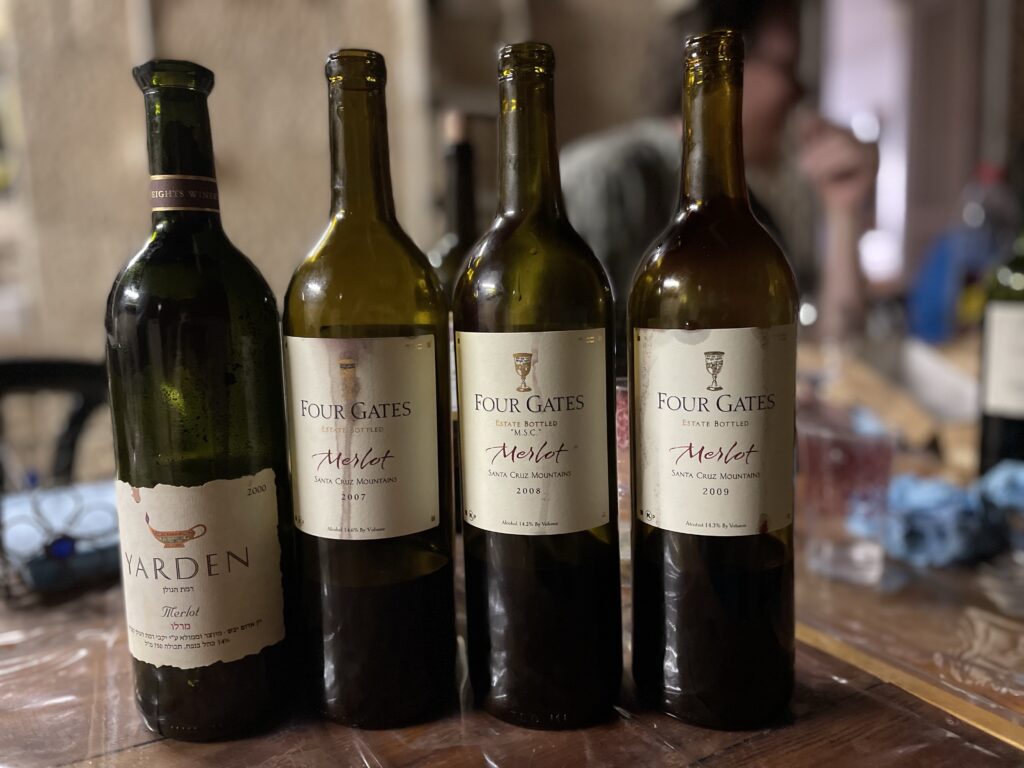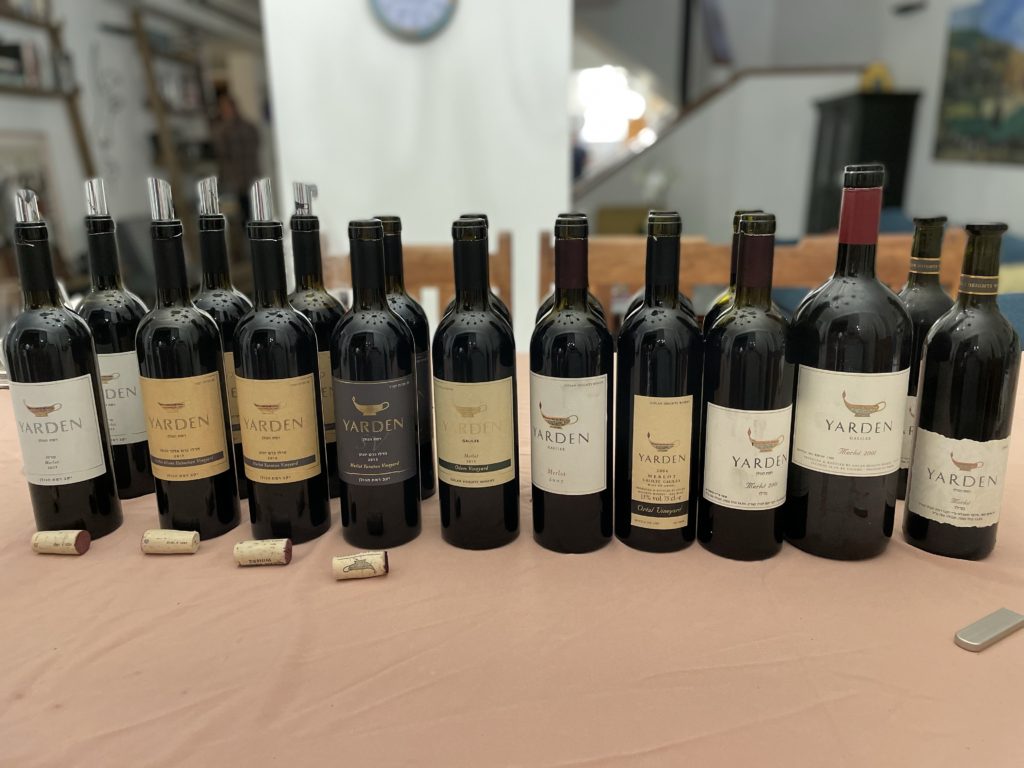Wow. It has been a VERY long time since I posted. I have been very busy both professionally and personally – starting a new position at my day job and my daughter getting married – and so I have had no free time to spend on writing. So, while I apologize, I do hope you will forgive me, dear reader.
My intention is to catch up with a number of posts dealing with topics I find interesting mixed with ratings of various pertinent bottles. The first of these being a very interesting tasting I was at of a number of older Four Gates bottles, which prompted me to really think about the difference between wines that thrive and develop with age and wines that survive over long periods of time but don’t really gain anything out of the aging process. [Of course I am only reffering to wines in this article that are buit for aging. 98% of wines on the market are designed specifically to be held for 1-3 years and not for long or even medium term (8-10 years) aging.] Over the last year for whatever reason, Merlot has been a focus, as, in addition to Four Gates I also tasted through a large number of Golan Heights Winery Merlots. The last winery I will focus on will be Herzog but, as you can guess, if you are talking about Herzog, you need to be talking Cabernet Sauvignon – and that’s what we will do.

Twice over the last year, my friend David Sterne has invited me over to his apartment in the Old City to taste through a number of Four Gates bottles. About a month ago, we tasted the 1999, 2000, MSC 2005, and MSC 2008 (MSC being the ‘reserve’ line). A year ago – September 2021 –,we tasted another three Four Gates Merlots – 2007, MSC 2008, and 2009, plus a 2000 Yarden Merlot. Additionally, I have had the 2013 and the 2011 (a few times) over the past year.

These mini vertical-tastings yielded interesting results. First, simply put, Binyamin Cantz’s wines need 20+ years before they are ready. I mean that. Wines at 15 years are still raging with acid and fruit, and none of those tertiary notes that I crave are anywhere near the front of the wine. When you taste them vertically, you can discern the movement of the wine in terms of mellowing. But, tasted individually, wines with 10-12 years of age sometimes taste like they were bottled yesterday. (Taste a new vintage Four Gates to see what impenetrable really is.) These wine only scratch their potential. Of the Four Gates bottles mentioned above, the 1999 (which I think was the third official Four Gates vintage) was not holding up well at all – but that may very well have been an off bottle, or ’99 was not a great vintage; I have no idea. A 23 year old wine is almost always going to be hit or miss to some extent, so who knows. But, the 2000 on the other hand, was in excellent shape and showed what you eventually want to achieve – rich balanced complexity where the tertiary notes (some nice smoke, dried tobacco and earth) really move more into the front of the wine, but you still have that wonderful ripe fruit balanced by the still very potent acid. At peak? I think it was my first time tasting this specific wine, so it’s hard to know – if I were to guess I would say at peak or just past.

If you take a look at my posting from a few months ago, I also tasted through a number of GHW Yarden Merlots – all sourced from the winery, so provenance and storage was not an issue. The results there speak for themselves. Bottom line, prior to 2003, Yarden wines had the ability to go the long haul. Quality fruit, excellent winemaking, and a cooperative climate means great wine. From 2003-2008, the wines took a slight detour – and while still very nice on release, when looking at them now through the lens of age, these wines simply don’t have the stamina of their older brothers. From 2009 onward, there is not much really to talk about. The style shift there – perhaps due to the shift in climate or perhaps simply to sell more wine – simply does not lend itself (IMHO) to long term aging. The fruit is ALREADY too ripe. By the time eight years have passed, the wines have progressed, but not in the direction one would hope.
This brings me of course to a central point – What is one looking for in an aged wine? This is a subjective question. I was speaking to someone in shul on Shabbat and he mentioned that he was hoping the wine would be smooth. “Smooth” is a descriptor I have heard often – but one that is not in place IMHO when speaking about quality wine. I believe it comes from people’s experience with whisky. Whisky is deemed smooth when there is little alcoholic burn when swallowing. While wines can be “hot” and have a noticeable alcoholic taste (a flaw for sure), outside of poorly made dry sherry, I have not heard people specifically complain of alcohol burn with wine. Smooth in wine apparently corresponds to a lack of perceived tannin and acid. But, those are the very things that one WANTS in a quality wine. Yes, you want them to be balanced – but if you are drinking wine and getting NO tannin or acid, you are drinking a dead wine. Apparently there is a large segment of the population that would rather have that, then a wine that had wonderful flavor and a nice core to support it. And so, most high quality wine is a WASTE for the average drinker unless it as at peak or more likely, a bit past. What I am looking for is that point at which tertiary notes just overtake the primary notes, and you get all of that mushroom and umami that is hidden in there to move to the front of the wine – while still having tannin and acid to hold the wine together without dominating it. That’s what I look for in an aged wine at its peak. But, as noted, I am likely in the minority.
This brings me to the last group of wines – and a conundrum. Herzog Wine Cellars. Their wines are naturally ubiquitous in the US and over the last five years have even made slight inroads here in Israel where. A good many of them are routinely top picks for me each year. But, and this is weird – even though they are almost always mevushal, the wines remain ridiculously YOUTHFUL even as they advance in age. I have tasted various wines from late 90’s vintages through recent releases most commonly at the mid to upper-mid range (let’s say from Alexander Valley through Chalk Hill). The wines barely move. Now, being mevushal, I think overall this is a huge complement. Herzog has proven decisively that one can make high quality mevushal wines that can last 25 years. That’s AWESOME. But I would say that of the three producers, if one is looking for development, Herzog wines developed the least. Now, this isn’t 100% fair. We aren’t comparing apples to apples here. Four Gates and GHW were Merlot, and Herzog was CS (though I would argue that this works in Herzog’s favor as it is easier to coax some of those notes out of big Cab’s than Merlot, but I’ll leave that alone). Also, to really do this right, you would want not only the same varietal, but the same vintages tasted for all of these wineries. Having said that, I am going to stand by my assessment overall. Now, I don’t want you to get the wrong idea. The wines DO move. The tannin does recede. The tertiary notes are more expressive – but – they rarely move front and center with Herzog wines. On the old GHW wines, this happened for sure. On the Four Gates wines you can see this happening with properly aged vintages, But with Herzog, for me, I’d like to see more development in this direction. Now, as I mentioned above, I am clearly in the minority. MY guess is that most of the kosher wine drinking public is VERY happy with the development they see from the Herzog wines. The wines drop some tannin, and the fruit for the most part stays balanced by the nice acidity, and so it is “easy drinking”. I can’t argue with that. And these are quality wines. I would venture to say that quality of the winemaking is in fact excellent even without taking into account the mevushal aspect – but think of the volume! Herzog produces an INSANE amount of wine and maintains a truly high level of quality in the range I am discussing.
Now – I have NOT addressed French, Spanish, or Italian producers here, for a variety of reasons. First and foremost, with French wines, this is not really a question. Pop a bottle of 2000 Smith Haute Laffite or Leoville Poyferre and you will have your answer. And it’s not just at the high end – even mid-range French wines can provide a beautifully aged experience. The examples really are endless.
Spanish wines of course also age. I had a 2003 Capcanes Peraj Habib a year ago that was exquisite. Elvi’s 2009’s are still not at peak but progressing wonderfully. With Italian wines, while there is much less available, those Falseco wines of the mid 2000’s aged beautifully (when stored well). And so, I concentrated on purely new world wines here, where for me, the progression is a bit less apparent. Secondly, production only really started to stabilize in France over the last decade. During the aughts (and certainly during the 90’s), production was sporadic and a fraction of the volume it is today. And that’s just France. Spain was producing very small amounts until the mid aughts when Elvi joined Capcanes in producing some truly age worthy wines. Italy is only really taking off now thanks to my friend Ralph Madeb of M & M. But really, there is no question about Old World wineries. Whatever quality wines were produced, showed clear progression as they aged.
So, are New World wines worth the wait? The answer is, it depends on what you are looking for. If you are looking for wines that really stick to the very fruity profile without being tannic or overly acidic, then you are looking at an aged bottle of Yarden that is about 8-10 years old. Not really what I’m after, but to each his own. On the other end of the scale, if you are looking for a wine with rich complexity and which still has bite – and you are crazily patient – and have deep pockets – and are lucky enough to be able to purchase before it sells out – then Four Gates DOES pay off in the long run. It just takes time. For your average drinker of finer aged wines, Herzog likely offers a sweet spot. When aged, these wines are balanced and downright youthful in their profile if not in their structure, so that the tannin somewhat recedes, producing a wine that does become more accessible with age, if not necessarily more complex, and at a reasonable price, within a reasonable timeframe. Having said that, clearly, the best results and biggest bang for your buck in terms of aging will be with Old World wines, as noted above. I’ll save the specifics for a similar post down the road.
Let me finish by saying, there are always exceptions. You can point to this bottle or that vintage and get a different result. The above is just my experience and how I view the wines. Also, there are others I could use as examples like Carmel Limited Edition, which I would recommend warmly though the 2016 vintage and for the most part aged exceptionally well for Israeli wines. Castel’s Grand Vin is another example. Why didn’t I focus on producers and labels other than GHW Yarden, like Carmel LE or Castel GV? Well, Yarden goes farther back than either of these and, for most of its history, was considered the gold standard in Israeli winemaking (though for an overview of some of Carmel Limited Edition, you can see a write up of mine from a few years ago that covers most of the vintages though 2011 – and for a similar overview of Castel Grand Vin, you can see my friend Alexander Kassel’s wonderful write up here – though it is in Hebrew). As always, there is no replacement for tasting wines yourself and figuring out what you like.
Happy drinking; I’m looking forward to writing a bit more frequently after the chagim. Cheers.
Pingback: Can Israeli Wine Age? - Kosher Wine Unfiltered